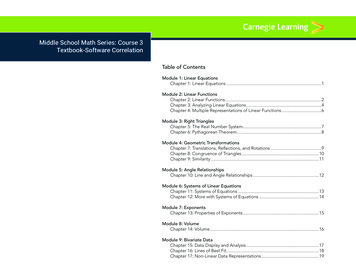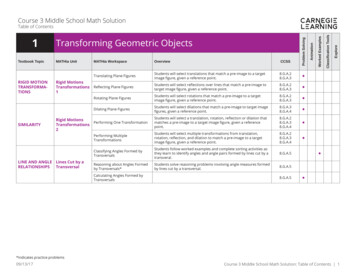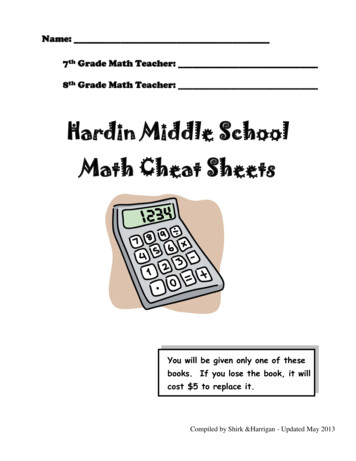
Transcription
Middle School Math Series: Course 3Textbook-Software CorrelationTable of ContentsModule 1: Linear EquationsChapter 1: Linear Equations.1Module 2: Linear FunctionsChapter 2: Linear Functions.2Chapter 3: Analyzing Linear Equations.4Chapter 4: Multiple Representations of Linear Functions. 6Module 3: Right TrianglesChapter 5: The Real Number System.7Chapter 6: Pythagorean Theorem. 8Module 4: Geometric TransformationsChapter 7: Translations, Reflections, and Rotations. 9Chapter 8: Congruence of Triangles. 10Chapter 9: Similarity.11Module 5: Angle RelationshipsChapter 10: Line and Angle Relationships.12Module 6: Systems of Linear EquationsChapter 11: Systems of Equations.13Chapter 12: More with Systems of Equations. 14Module 7: ExponentsChapter 13: Properties of Exponents. 15Module 8: VolumeChapter 14: Volume. 16Module 9: Bivariate DataChapter 15: Data Display and Analysis.17Chapter 16: Lines of Best Fit.18Chapter 17: Non-Linear Data Representations. 19
Middle School Math Series: Course 3Textbook-Software CorrelationModule 1Linear EquationsTextbookChapter11.1MATHia XTitleLearning GoalsLinear EquationsThis chapter focuses on strategies to solve linear equations in one variable with one solution, infinitelymany solutions, and no solutions. Equations include rational number coefficients and require the use of theDistributive Properties.A Park Ranger’sWork Is NeverDoneSolving ProblemsUsing Equations Write and solve two-step equations to represent problemsituations. Solve two-step equations.CCSSM8.EE.7.a8.EE.7.bWhy Doesn’t ThisWork?1.2Equations withInfinite or NoSolutions Identify and solve equations that have infinite solutions. Identify and solve equations that have no solutions.Who Has theMost?1.3 Write and solve linear equations.Solving LinearEquations inverse operationstwo-step equationsolutioncoefficientconstantProperties of EqualitySoftware UnitSoftware WorkspaceSolving LinearEquationsWorkspace 1:Workspace 2:Exploring Two-Step EquationsSolving Multi-Step EquationsWorkspace 1:Workspace 2:Workspace 3:Solving with Integers (No Type In)Solving with Integers (Type In)Solving Equations with One Solution,Infinite, and No SolutionsSorting Equations by Number ofSolutionsLinear Equationswith Variables onBoth Sides(Systems of LinearEquations Module)8.EE.7.a8.EE.7.bLinear Models andthe DistributivePropertyGames andPractice1.48.EE.7.a8.EE.7.bKey Terms Solve linear equations.Solving MoreLinear EquationsMiddle School Math Series: Course 38.EE.7.a8.EE.7.bWorkspace 4:Workspace 1:Workspace 2:Workspace 3:Modeling with Integer Rates of ChangeModeling with Fractional Rates ofChangeModeling using the DistributiveProperty over Division1
Middle School Math Series: Course 3Textbook-Software CorrelationModule 2Linear FunctionsTextbookChapter2MATHia XTitleLearning GoalsCCSSMKey TermsLinear FunctionsThis chapter develops the understanding that a function is a rule that assigns to each input exactly one output.Real-world problems, tables, graphs, and equations are used to model linear function relationships. Non-linearfunctions are introduced to contrast with linear functions.Software UnitSoftware WorkspaceRelations andFunctionsWorkspace 1:Workspace 2:Workspace 3:Exploring FunctionsExploring Graphs of FunctionsClassifying Relations and FunctionsWorkspace 4:Identifying Key Characteristics ofGraphs of FunctionsPatterns, Patterns,Patterns 2.1DevelopingSequences ofNumbers fromDiagrams andContextsEvery Graph Tellsa Story2.2DescribingCharacteristics ofGraphsTo Be or Not ToBe a Function?2.3Defining andRecognizingFunctionsScaling a Cliff2.4Linear FunctionsU.S. Shirts2.5Using Tables,Graphs, andEquations, Part 1 Write sequences of numbers generated from the creation ofdiagrams and written contexts. State varying growth patterns of sequences.8.F.1 sequence term ellipsis Describe characteristics of graphs using mathematicalterminology. Describe a real-world situation that could be represented bya given graph.8.F.18.F.5 discrete graphcontinuous graphlinear graphcollinear pointsnon-linear graph Define relation and function. Determine whether a relation (represented as a mapping,set of ordered pairs, tables, sequence, graph, equation, orcontext) is a function.8.F.18.F.28.F.38.F.5 atter plotvertical line test Make input-output tables for linear functions. Graph linear functions. Determine characteristics of linear functions.8.F.18.F.28.F.38.F.48.F.5 linear function Use different models to represent a problem situation. Determine an initial value when given a final result. Identify the advantages and disadvantages of using aparticular representation.8.F.18.F.28.F.38.F.48.F.5Middle School Math Series: Course 3Relations andFunctions2
Middle School Math Series: Course 3Textbook-Software CorrelationTextbookChapterTitleLearning GoalsHot Shirts2.6Using Tables,Graphs, andEquations, Part 2MATHia XCCSSM Use different methods to represent a problem situation. Estimate values of expressions that involve decimals. Determine an initial value when given a final result.8.F.18.F.28.F.38.F.48.F.5 estimation point of intersection Define, graph, and analyze non-linear functions, includingabsolute value, area of a square, and volume of a cube.8.F.18.F.28.F.5 absolute value function square or quadraticfunction cube or cubic functionWhat, Not Lines?2.7Introductionto Non-LinearFunctionsKey TermsMiddle School Math Series: Course 3Software UnitSoftware Workspace3
Middle School Math Series: Course 3Textbook-Software CorrelationTextbookChapter3Learning GoalsAnalyzing LinearEquationsThis chapter focuses on the rate of change of linear functions that are represented in graphical displays,tables, and in real-world problem situations. Slope is defined and the slope-intercept form of a linear equationis introduced.Hitting the Slopes3.1Determining Rateof Change from aGraphAt the Arcade3.2Determining Rateof Change from aTableTo Put It InContext3.3Determining Rateof Change from aContextAll Together Now!3.4Determining Rateof Change froman EquationWhere It Crosses3.5MATHia XTitleDeterminingy-Interceptsfrom VariousRepresentations Determine the rate of change from a graph. Create a scenario, a table, and an equation from a graph. Connect the rate of change represented in a graph to therate of change in other representations. Use rise/run to calculate the rate of change from a graph. Determine if a graph has a rate of change that is increasing,decreasing, zero, or undefined. Compare unit rates of change in the same graph.CCSSM8.EE.58.F.18.F.28.F.38.F.48.F.5 Determine the rate of change from a table of values. Create a graph, a context, and an equation from a table ofvalues. Connect the rate of change represented in a table of valuesto the rate of change in other representations. Use y2 – y1 / x2 – x1 to calculate the rate change from a table ofvalues or two coordinate pairs. Determine whether a table of values will make a straight lineif graphed.8.F.28.F.4 Determine the rate of change from a context. Create a graph, a table, and an equation from a context. Connect the rate of change represented in a context to therate of change in other representations. Generate the values of two coordinate pairs from informationgiven in context.8.F.18.F.4 Determine the rate of change from an equation that has beensolved for y. Create a table, a scenario, and a graph from an equation. Connect the rate of change represented in an equation to therate of change in other representations. Determine if an equation has a rate of change that isincreasing, decreasing, zero, or undefined. Compare rates of change by comparing the coefficients of xin different equations.8.F.18.F.38.F.4 Determine the y-intercept of a linear function from a context,a table, a graph, or an equation. Write the y-intercept in coordinate form. Explain the meaning of the y-intercept when given thecontext of a linear function. Explain how the y-intercept is useful in graphing a linearfunction. Explain what makes a relationship a direct variation.8.EE.58.F.18.F.38.F.4Middle School Math Series: Course 3Key Terms Software UnitSoftware Workspaceraterate of changeperunit rateriserunrise/run first differencesWorkspace 1:Linear ModelsWorkspace 2:Graphing Given an Integer Slope andy-InterceptGraphing Given a Decimal Slope andy-Intercept slope slope-intercept form y-intercept direct variation4
Middle School Math Series: Course 3Textbook-Software 3.6Determining theRate of Changeand y-InterceptLearning Goals Graph lines using the slope and y-intercept. Calculate the y-intercept of a line when given the slope andone point that lies on the line. Write equations of lines in slope-intercept form if given twopoints that lie on the line or the slope and one point that lieson the line. Write equations in point-slop form if given the slope and onepoint that lies on the line. Graph lines in standard form by using the intercepts. Convert equations from point-slope form and standard formto slope-intercept form. Discuss the advantages and disadvantages of point-slopeand standard form.Middle School Math Series: Course 3MATHia XCCSSM8.F.18.F.38.F.4Key Terms point-slope form standard formSoftware UnitSoftware WorkspaceLinear ModelsWorkspace 3:Modeling Linear Equations in StandardFormGraphs of LinearEquations in TwoVariablesWorkspace 1:Graphing Linear Equations using aGiven MethodGraphing Linear Equations using aChosen MethodWriting Equations ofa LineWorkspace 1:Workspace 2:Workspace 3:Workspace 4:Workspace 2:Modeling Given Slope and a PointCalculating SlopesModeling Given Two PointsModeling Given an Initial Point5
Middle School Math Series: Course 3Textbook-Software CorrelationTextbookChapter4Learning GoalsMultipleRepresentationsof LinearFunctionsThis chapter focuses on using the multiple representations of functions to solve real-world problems.Willie Catchem4.1AnalyzingProblemSituationsUsing MultipleRepresentationsPony Express4.2Interpreting theStandard Form ofa Linear EquationSlopes, Forms,Graphs, andIntercepts4.34.4Connecting theStandard Formwith the SlopeIntercept Form ofLinear FunctionsThe JourneyStarts with aSingle Step—ButThere Are ManySteps After That!Intervals ofIncrease,Decrease, and NoChangePiecewiseFunctions4.5MATHia XTitleDevelopingthe Graph ofa PiecewiseFunctionCCSSMKey Terms Analyze problem situations using multiple representations.8.EE.58.EE.7.b8.F.18.F.28.F.38.F.4 Use the standard form of a linear equation to represent aproblem situation. Use the standard form to analyze and solve problems. Identify the meaning and value of the component expressionsin the standard form of a linear equation.8.EE.7.b8.F.18.F.28.F.4 Graph linear functions in standard form. Transform linear functions from one form to the other. Determine the slope and the intercept of linear equations instandard form.8.EE.7.b8.F.18.F.28.F.38.F.4 Analyze a problem situation using multiple representations. Identify intervals of increase, decrease, and constant valuesof a function.8.F.18.F.28.F.48.F.5 Develop the graph of a piecewise function from a contextwith or without a table of values. Represent a piecewise function algebraically by usingappropriate notation, equations, and their domains. Graph piecewise functions from contexts with or withoutdiagrams. Physically model the graphs of piecewise functions usingtechnology.8.F.18.F.48.F.5 piecewise functionMiddle School Math Series: Course 3Software UnitSoftware WorkspaceWriting Equations ofa LineWorkspace 5:Modeling Linear Functions usingMultiple Representationsincreasing functionconstant functiondecreasing functioninterval of increaseinterval of decreaseconstant interval6
Middle School Math Series: Course 3Textbook-Software CorrelationModule 3Right TrianglesTextbookChapter55.1Learning GoalsThe Real NumberSystemThis chapter extends the understanding of properties of numbers and number systems to include irrationaland real numbers.Is It a Bird or aPlane?Rational NumbersSew What?5.2MATHia XTitleIrrationalNumbersCCSSM Use a number line to compare and order rational numbers. Learn about types of numbers and their properties. Perform operations with rational numbers.7.NS.3 natural numbers (countingnumbers) whole numbers integers closed rational numbers Identify decimals as terminating or repeating. Write repeating decimals as fractions. Identify irrational number.8.NS.18.NS.28.EE.2 Classify numbers in the real number system. Understand the properties of real numbers.8.NS.1 real number Venn diagram closureWorth 1000Words5.3Real Numbersand TheirPropertiesKey TermsMiddle School Math Series: Course 3irrational numberterminating decimalrepeating decimalbar notationSoftware UnitRational andIrrational NumbersSoftware WorkspaceWorkspace 1:Workspace 2:Workspace 3:Introduction to Irrational NumbersGraphing Real Numbers on a NumberLineOrdering Rational and IrrationalNumbers7
Middle School Math Series: Course 3Textbook-Software CorrelationTextbookChapter66.1Learning GoalsPythagoreanTheoremThis chapter develops the Pythagorean Theorem and the Converse of the Pythagorean Theorem. Thesetheorems are then applied to solve real-world problems in two and three dimensions.Soon You WillDetermine theRight TriangleConnection Use mathematical properties to discover the PythagoreanTheorem. Solve problems involving right triangles.The PythagoreanTheoremCan That BeRight?6.2MATHia XTitleThe Converse ofthe PythagoreanTheoremPythagoras to theRescue6.3Solving forUnknown LengthsCCSSM8.NS.28.EE.28.G.68.G.7Key Terms right triangleright angleleghypotenusediagonal of a squarePythagorean TheoremtheorempostulateproofSoftware UnitSoftware WorkspaceThe PythagoreanTheoremWorkspace 1:Workspace 2:Exploring the Pythagorean TheoremApplying the Pythagorean Theorem Use the Pythagorean Theorem and the Converse of thePythagorean Theorem to determine unknown side lengths inright triangles.8.EE.28.G.68.G.78.G.8 converse Converse of thePythagorean Theorem Pythagorean triple Use the Pythagorean Theorem and the Converse of thePythagorean Theorem to determine the unknown sidelengths in right triangles.8.EE.28.G.7The PythagoreanTheoremWorkspace 3:Problem Solving using the PythagoreanTheorem Use the Pythagorean Theorem to determine the distancebetween two points in a coordinate system.8.EE.28.G.78.G.8The PythagoreanTheoremWorkspace 4:Calculating Distances on theCoordinate Plane Use the Pythagorean Theorem to determine the length ofdiagonals in two-dimensional figures.8.EE.28.G.78.G.8 Use the Pythagorean Theorem to determine the length of adiagonal of a solid. Use a formula to determine the length of a diagonal of arectangular solid given the lengths of three perpendicularedges. Use a formula to determine the length of a diagonal of arectangular solid given the diagonal measurements of threeperpendicular sides.8.EE.28.G.78.G.8Meeting Friends6.4The DistanceBetween TwoPoints in aCoordinateSystemDiagonally6.56.6Diagonals in TwoDimensionsTwo DimensionsMeet ThreeDimensionsDiagonals inThree DimensionsMiddle School Math Series: Course 38
Middle School Math Series: Course 3Textbook-Software CorrelationModule 4Geometric TransformationsTextbookChapter7Learning GoalsTranslations,Reflections, andRotationsThis chapter focuses on translations, rotations, and reflections of geometric figures on a coordinate plane.Sliding Right, Left,Up, Down, andDiagonally7.1TranslationsUsing GeometricFiguresSliding Lines7.2Translations ofLinear FunctionsRotations ofGeometricFigures on theCoordinate PlaneCCSSMKey TermsSoftware UnitSoftware ansformationsof Figures on theCoordinate PlaneWorkspace 1:Translating Plane Figures Translate geometric figures horizontally. Translate geometric figures vertically. Understand that a two-dimensional figure is congruent toanother if the second can be obtained from the first by asequence of translations.8.G.1.a8.G.28.G.3 Translate linear functions horizontally and vertically. Use multiple representations such as tables, graphs, andequations to represent linear functions and the translations oflinear functions.8.G.1.a Rotate geometric figures on the coordinate plane.8.G.1.a8.G.1.b8.G.28.G.3 rotation angle of rotation point of rotationTransformationsof Figures on theCoordinate PlaneWorkspace 2:Rotating Plane Figures Reflect geometric figures over the axes on the coordinateplane. Reflect geometric figures over lines on the coordinate plane.8.G.1.a8.G.28.G.3 reflection reflection lineTransformationsof Figures on theCoordinate PlaneWorkspace 3:Reflecting Plane FiguresRound and RoundWe Go!7.3MATHia XTitle Mirror, Mirror7.4Reflectionsof GeometricFigures on theCoordinate PlaneMiddle School Math Series: Course 39
Middle School Math Series: Course 3Textbook-Software CorrelationTextbookChapter8MATHia XTitleLearning GoalsCCSSMKey TermsCongruence ofTrianglesThis chapter focuses on the effect of translations, rotations, and reflections of triangles using coordinates.Software UnitSoftware WorkspaceSlide, Flip, Turn!8.1Translations,Rotations, andReflections ofTrianglesAll the Same toYou8.2CongruentTrianglesTwo Ways to Tell8.3SSS and SASCongruenceAnd Here’s TwoMore!8.4ASA and AASCongruence Translate triangles in a coordinate plane. Rotate triangles in a coordinate plane. Reflect triangles in a coordinate plane.8.G.3 Identify corresponding sides and corresponding angles ofcongruent triangles. Explore the relationship between corresponding sides ofcongruent triangles. Explore the relationship between corresponding angles ofcongruent triangles. Write statements of triangle congruence. Identify and use transformations to create new images.8.G.1.a8.G.1.b8.G.28.G.38.G.8 Explore the SSS Congruence Theorem. Explore the SAS Congruence Theorem. Use the SSS and SAS Congruence Theorems to identifycongruent triangles.8.G.1.a8.G.1.b8.G.2 SSS Congruence Theorem included angle SAS Congruence Theorem Explore the ASA Congruence Theorem. Explore the AAS Congruence Theorem. Use the ASA and AAS Congruence Theorems to identifycongruent triangles.8.G.1.a8.G.1.b8.G.2 included side ASA Congruence Theorem AAS Congruence TheoremMiddle School Math Series: Course 3congruent line segmentscongruent anglescorresponding sidescorresponding angles10
Middle School Math Series: Course 3Textbook-Software CorrelationTextbookChapter9Learning GoalsSimilarityThis chapter explores dilations of triangles to develop the concept of similarity. The Angle-Angle SimilarityTheorem, Side-Angle-Side Similarity Theorem, and the Side-Side-Side Similarity Theorem are developed asefficient methods to demonstrate that two triangles are similar.Expanding YourMind9.1Dilations ofTrianglesLook-Alikes9.2Similar TrianglesProve It!9.3AA, SAS, andSSS SimilarityTheoremsBack on the Grid9.4MATHia XTitleSimilar Triangleson the CoordinatePlane Dilate triangles that result in an enlargement of the originaltriangle. Dilate triangles that result in a reduction of the originaltriangle. Dilate triangles in a coordinate plane.CCSSMKey Terms8.G.38.G.4 dilationcenter of dilationscale factordilation factorenlargementreduction Define similar triangles.Identify the corresponding parts of similar triangles.Write triangle similarity statements.Determine the measure of corresponding parts of similartriangles.8.G.38.G.4 similar triangles Explore the AA Similarity Theorem.Explore the SAS Similarity Theorem.Explore the SSS Similarity Theorem.Use the AA, SAS, and SSS Similarity Theorems to identifysimilar triangles.8.G.38.G.4 AA Similarity Theorem SAS Similarity Theorem SSS Similarity Theorem Graph similar triangles and determine the dilation factor.Dilate triangles to form similar triangles.Verify that triangles are similar using Similarity Theorems.Determine the coordinates of a point needed to form similartriangles.8.G.38.G.4Middle School Math Series: Course 3Software UnitSoftware WorkspaceTransformationsof Figures on theCoordinate PlaneWorkspace 4:Dilating Plane FiguresTransformationsof Figures on theCoordinate PlaneWorkspace 5:Workspace 6:Performing One TransformationPerforming Multiple Transformations11
Middle School Math Series: Course 3Textbook-Software CorrelationModule 5Angle RelationshipsTextbookChapter1010.1MATHia XTitleLearning GoalsLine and AngleRelationshipsThis chapter focuses on line and angle characteristics and relationships. It begins with the relationships thatcan exist between two lines, then moves to the relationships between angles when intersected by a line, andfinally concludes with transformations related to parallel and perpendicular lines.Location,Location,Location!CCSSM Explore possible relationships between two lines in Euclideangeometry.8.G.5 7.G.58.G.5 supplementary angles linear pair of angles8.G.5 Line RelationshipsWhen Lines ComeTogether10.2AngleRelationshipsFormed by TwoIntersecting med by TwoLines Intersectedby a TransversalParallel orPerpendicular?10.4Slopes of Paralleland PerpendicularLinesUp, Down, and AllAround10.5LineTransformationsKey TermsExplore the angles determined by two intersecting lines.Identify congruent angles.Identify adjacent angles.Identify vertical angles.Identify a linear pair of angles.Identify supplementary angles.Solve for the supplement of an angle. Explore the angles determined by two lines that areintersected by a transversal. Explore the measures of angles determined by two parallellines that are intersected by a transversal. Identify alternate interior angles. Identify alternate exterior angles. Identify same-side interior angles. Identify same-side exterior angles. Identify corresponding angles. Determine the measure of alternate interior angles, alternateexterior angles, same-side interior angles, same-side exteriorangles, and corresponding angles. Determine the slopes of parallel lines.Determine the slopes of perpendicular lines.Identify parallel lines.Identify perpendicular lines. Explore transformations related to parallel lines. Explore transformations related to perpendicular lines.Middle School Math Series: Course 3Software UnitSoftware Workspaceintersecting linesplaneperpendicular linesparallel linescoplanar linesskew linescoincidental linestransversalalternate interior anglesalternate exterior anglessame-side interior anglessame-side exterior angles8.F.38.G.1.c8.G.5 reciprocal negative reciprocal8.EE.68.G.1.a8.G.1.b8.G.1.c8.G.5 Triangle Sum TheoremWorkspace 1:Lines Cut by aTransversalWorkspace 2:Classifying Angles Formed byTransversalsCalculating Angles Formed byTransversals12
Middle School Math Series: Course 3Textbook-Software CorrelationModule 6Systems of Linear EquationsTextbookChapter11Learning GoalsSystems ofEquationsThis chapter introduces linear systems of equations. The focus is to understand that a solution to a systemof two linear equations in two variables corresponds to the point of intersection of their graphs, and thatthere is no solution if the equations are parallel and the lines will never intersect. The substitution method isintroduced as an algebraic strategy to determine a solution to a linear system of equations.Producing andSelling T-Shirts11.1Using a Graphto Solve a LinearSystemSaving Money11.2Graphs andSolutions ofLinear Systems Write a system of equations to represent a problem context. Solve a system of equations graphically. Interpret the solution to a system of equations in terms of theoriginal problem’s context.Using Substitutionto Solve a LinearSystem, Part 1Using Substitutionto Solve a LinearSystem, Part 28.EE.8.a8.EE.8.cKey Terms Software Unitprofitincomepoint of intersectionbreak-even point8.EE.8.a8.EE.8.b8.EE.8.c Write a system of equations to represent a problem context. Solve a system of equations algebraically using substitution.8.EE.7.b8.EE.8.a8.EE.8.b8.EE.8.c substitution methodsystem of linear equationssolution of a linear systemconsistent systeminconsistent systemindependent systemdependent system Write a system of equations to represent a problem context. Solve a system of equations algebraically using substitution.Middle School Math Series: Course 3Software WorkspaceWorkspace 1:Systems of LinearEquationsSystems of LinearEquationsTickets, Please11.4CCSSM Write a system of equations to represent a problem context. Solve a system of equations graphically. Interpret the solution to a system of equations in terms of theoriginal problem’s context. Use slope to determine parallel and perpendicular lines.The County Fair11.3MATHia XTitleWorkspace 2:Workspace 3:Modeling Linear Systems InvolvingIntegersModeling Linear Systems InvolvingDecimalsSolving Linear Systems 3
Middle School Math Series: Course 3Textbook-Software CorrelationTextbookChapter12Learning GoalsMore withSystems ofEquationsThis chapter continues to develop strategies to solve linear systems of equations. The linear combinationmethod and graphing calculators are introduced as strategies to determine solutions to systems.System ofEquations12.1Using LinearCombinationsto Solve a LinearSystemWhat’s for Lunch?12.2Solving MoreSystemsMaking Decisions12.3MATHia XTitleUsing the BestMethod to Solvea Linear SystemCCSSM Write a system of equations to represent a problem context. Solve a system of equations algebraically using linearcombinations (elimination).8.EE.7.b8.EE.8.a8.EE.8.b8.EE.8.c Write a linear system of equations to represent a problemcontext. Choose the best method to solve a linear system ofequations.8.EE.7.b8.EE.8.a8.EE.8.b8.EE.8.c Write a linear system of equations to represent a problemcontext. Choose the best method to solve a linear system ofequations.8.EE.7.b8.EE.8.a8.EE.8.b8.EE.8.c Write a linear system of equations to represent a problemcontext.8.EE.8.a8.EE.8.b8.EE.8.c Write a linear system of equations to represent a problemcontext. Use a graphing calculator to solve a linear system ofequations.8.EE.7.b8.EE.8.a8.EE.8.b8.EE.8.cKey TermsSoftware UnitSoftware Workspace linear combinationsmethod (elimination)Going Green12.4Using a GraphingCalculator toSolve LinearSystemsBeyond the Pointof Intersection12.5Using a GraphingCalculator toAnalyze a SystemMiddle School Math Series: Course 314
Middle School Math Series: Course 3Textbook-Software CorrelationModule 7ExponentsTextbookChapter13MATHia XTitleLearning GoalsProperties ofExponentsThis chapter develops the properties of exponents and includes scientific notation.ExponentiallySpeaking13.1Powers andExponents Expand a power into a product. Write a product as a power. Simplify expressions containing integer exponents.CCSSM8.EE.1Key TermsSoftware UnitSoftware Workspace power base exponentWorkspace 1:Digital Storage13.2Multiplying andDividing PowersExtending theRules13.3Zero andNegativeExponentsLet’s GetScientific!13.4ScientificNotationAre We ThereYet? What Is theDistance?13.5Operationswith ScientificNotationWatch Your Step!13.6Identifying theProperties ofPowers Develop a rule to simplify a product of powers. Develop a rule to simplify a power of a power. Develop a rule to simplify a quotient of powers.Properties of WholeNumber Exponents8.EE.1Workspace 2:Workspace 3:Workspace 4: Write numbers as powers. Simplify powers that have an exponent of zero. Simplify powers with negative exponents.8.EE.1 Express numbers in scientific notation. Express numbers in standard form. Perform operations using scientific notation.8.EE.18.EE.38.EE.4Properties of WholeNumber Exponents Review the Power of a Power Property.Review the Power of a Product Property.Review the Power of a Quotient Property.Review multiplication and division of numbers written inscientific notation.Middle School Math Series: Course 3Workspace 5:Simplifying Expressions with Negativeand Zero ExponentsWorkspace 1:Workspace 2:Using Scientific NotationComparing Numbers using ScientificNotationscientific notationorder of magnitudemantissacharacteristicScientific Notation Perform operations using scientific notation. Perform operations on numbers written in scientific notation. Use rules for significant digits in computation.Using the Product Rule and theQuotient RuleUsing the Power to a Power RuleUsing the Product to a Power Rule andthe Quotient to a Power RuleUsing Properties of Exponents withWhole Number Powers8.EE.18.EE.38.EE.48.EE.18.EE.28.EE.38.EE.415
Middle School Math Series: Course 3Textbook-Software CorrelationModule 8VolumeTextbookChapter14Learning GoalsVolumeThis chapter develops formulas for the volumes of cones, right circular cylinders, and spheres. Volumeformulas are used to solve real-world problems.Dr
Middle School Math Series: Course 3 3 Middle School Math Series: Course 3 Textbook-Software Correlation Textbook MATHia X Chapter Title Learning Goals CCSSM Key Terms Software Unit Software Workspace 2.6 Hot Shirts Using Tables, Graphs, and Equations, Part 2










